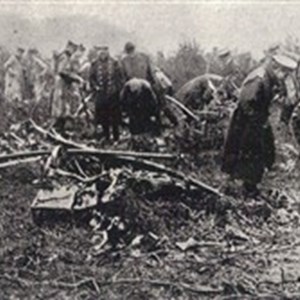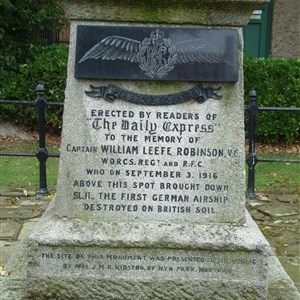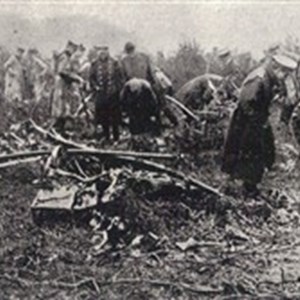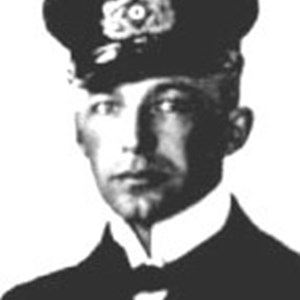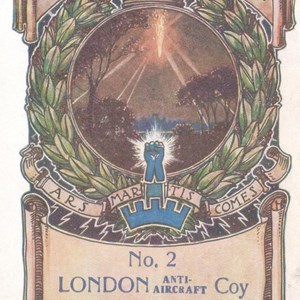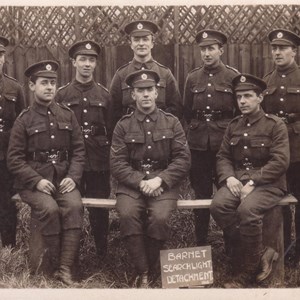Zeppelin Raids
Many today believe that the First World War never came to British soil. However, from May 1915 onwards Zeppelin bomber raids directed at London became an increasingly regular occurrence in what has become known as the ‘First Blitz’. As the flight path from the North Sea crossed Hertfordshire there are isolated incidents in which Hertfordshire came under Zeppelin attack.
Cuffley Air Crash, September 1916
On the night of the 3rd September 1916 the war arrived in a very real way to the small village of Cuffley. A Schutte-Lanz airship SL-11 (a wooden airship which was lighter than a Zeppelin) was on a bombing raid over London and was successfully attacked by 2nd Lieutenant (later Captain) William Leefe Robinson of the No.39 Home Defence Squadron. His small biplane used a new type of incendiary ammunition to set the ship alight. SL-11 came down to earth behind the Plough Inn at Cuffley. The entire 15-man crew was killed. It became the first airship shot down on British soil and Leefe Robinson was awarded the Victoria Cross for his actions. A memorial stands on the sight of the crash today.
Images: The crash site at Cuffley, propaganda produced about the event and the memorial to Leefe Robinson.
Essendon Bombing, September 1916
Essendon was bombed in the early hours of the 2nd-3rd September 1916, as a consequence of the fate of SL-11. A separate Zeppelin airship, L-16 commanded by Erich Sommerfeld, saw the flames ahead and turned North to escape the attentions of the Home Defence Corps. To speed their escape the bomb load was jettisoned over Essendon where searchlights had been stationed. A few houses and part of the church were destroyed. In one of the houses the two daughters of the village blacksmith, aged 26 and 12, were killed. The elder girl, Frances, had suffered wounds to the stomach and died quickly. The younger girl, Eleanor, suffered injury to her leg and passed away despite amputation. A plaque on the church wall commemorates the event today.
Cheshunt Raids, September 1915 and October 1916
Cheshunt was attacked twice by airships. The first time on the night of the 7th-8th September 1915 when several dozen small bombs destroyed a row of greenhouses which had probably been mistaken for a row of factory roofs. More frightening would have been the second raid of the 1st-2nd October 1916 which saw six acres of greenhouses destroyed and damage to 350 houses, but there were no casualties.
Potters Bar Air Crash, October 1916
In the early hours of the 1st October 1916 Zeppelin L-31 was part of a major raid of 11 airships on London. On hearing the airships were heading for London, pilot Wulstan Joseph Tempest of the No.39 Home Defence Squadron had ignored orders to patrol the Thames and had instead taken his tiny biplane to a high altitude in hope of crossing their path. His luck was in.
Reporter Michael MacDonagh described the last moments of the zeppelin as a ‘a gigantic pyramid of flames, red and orange, like a ruined star falling slowly to earth.’ The Zeppelin limped away but only as far as Potters Bar. It eventually came down over Oakmere Park. The entire crew were killed including commander Lieutenant Heinrich Mathy, the record holder for the highest number of Zeppelin raids over Britain during the First World War. Mathy is the only example of a Captain choosing to jump out an airship prior to crashing, and also the only person to have momentarily survived the landing. Local farmers found Mathy still wrapped in his leather flying jacket, face up in the field near the burning wreckage. He only lived for a few minutes.
Pilot Wulstan Joseph Tempest received a DSO (Distinguished Service Order) for his actions. There is even a Tempest Avenue named after him near to Oakmere Park as a tribute to his actions.
Images (from left to right): The Potters Bar crash site, Lt. Heinrich Mathy and visitors to the crash site.
Also involved in the destruction of Zeppelin L31 on 1st October 1916 was the Hertfordshire based Barnet Searchlight Detachment. On the night in question they were crewing a specially equipped tram, painted in dark green, with a searchlight mounted on it. From their position outside Barnet church they were able to illuminate the raider during the course of the engagement thereby greatly aiding the work of Tempest as he attacked the airship. The men of the Barnet Searchlight Detachment were roundly praised by locals for their contribution to this important Herts based wartime episode. A letter of thanks written by the residents of Bedford Avenue provides an interesting insight into the event and the effect that a Zeppelin raid must have had on the local populous. You can read the letter here.
Images Courtesy of David Marks
Bombing of Willian, October 1916
The fate of Zeppelin L-31 over Potters Bar held tragic consequences for the small village of Willian, just outside Hitchin. The commander of Zeppelin L-24 was following only miles behind L-31 and witnessed the airship’s fate. It seems at this point the airship altered course in fear of a similar outcome. At 01.14 in the morning it dropped over 50 bombs on the area, after spotting the lights of a small airfield outside the village. Little damage was done but a soldier from the Royal Defence Corps was killed in the raid. The casualty of the raid was one Private William Hawkes of Stopsley, Bedfordshire. William was reported missing during the raid and his body was found at approximately 1.50am on 2nd October 1916. He had been hit in the chest by a piece of shell and was found 'still warm but quite dead'. The Coroner's inquest the following week reported that he had been killed in action whilst doing his duty. Private Hawkes is today buried in Stopsley Cemetery, Bedfordshire.
The route taken by L-24 that night was reported by many people on the ground all over the east of England. You can see the route here:
Hertford Raids, October 1915
On the 13th/14th October 1915 the county suffered its most devastating raid at Hertford. By this point many towns and villages were enforcing a ‘black-out’ with any the news of Zeppelins. However, Hertford failed to do so, and forty-eight bombs hit the town and destroyed several buildings in Bull Plain and North Street. Nine were killed and 15 injured. Many of those killed had come out of their houses to watch the airships.
Further reading:
http://www.iancastlezeppelin.co.uk/
http://www.pbhistory.co.uk/war/zeppelinreport.html
http://www.richthofen.com/dark_autumn/


